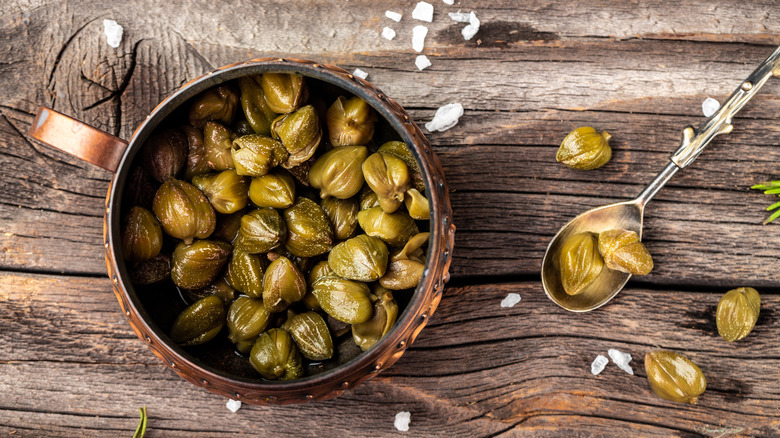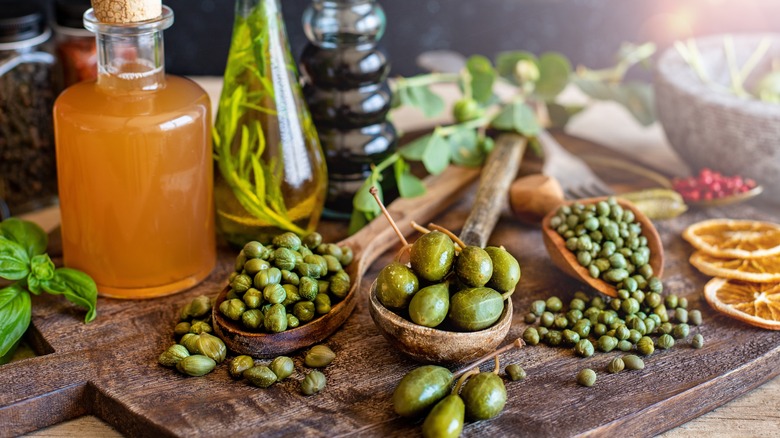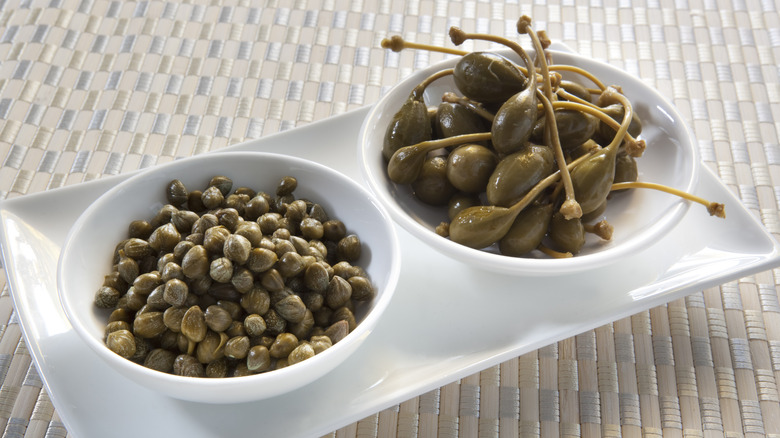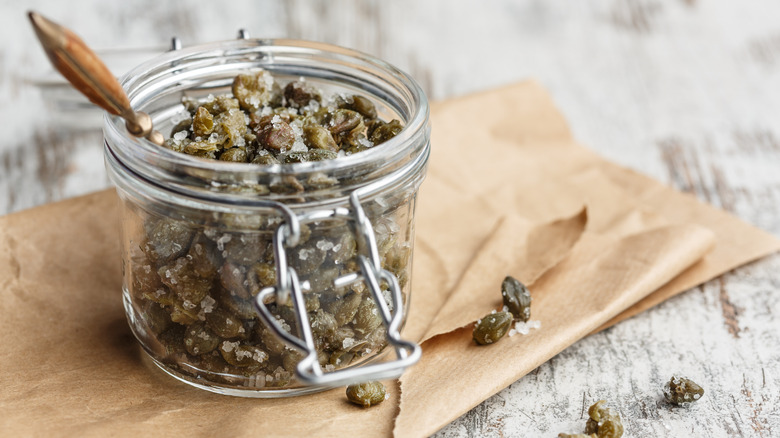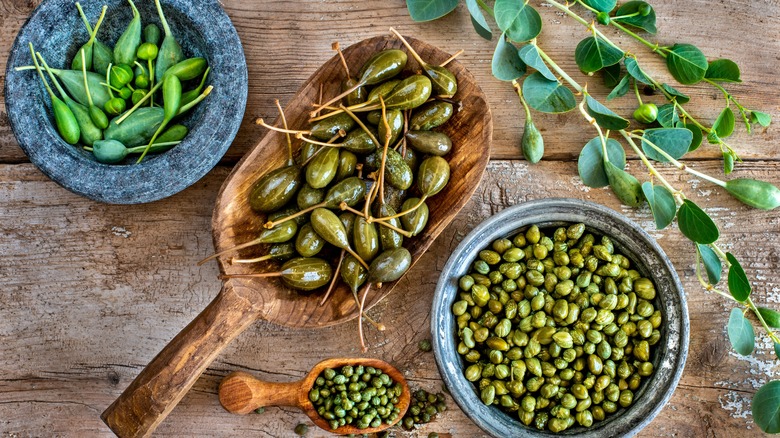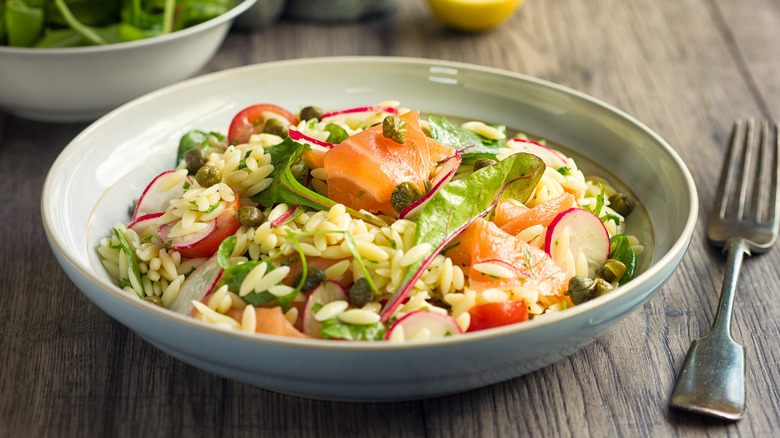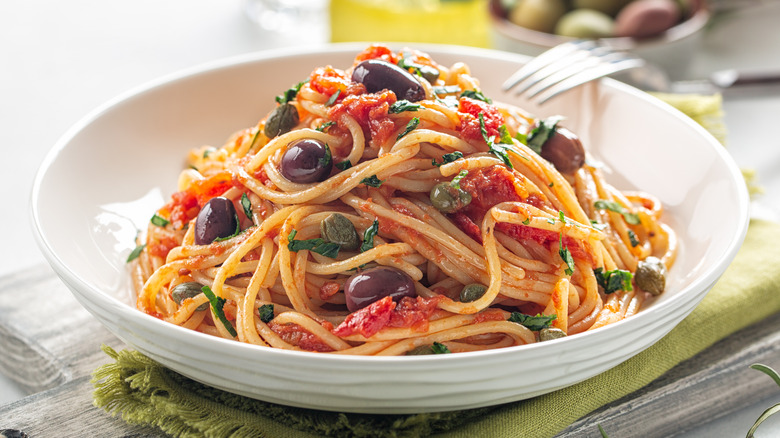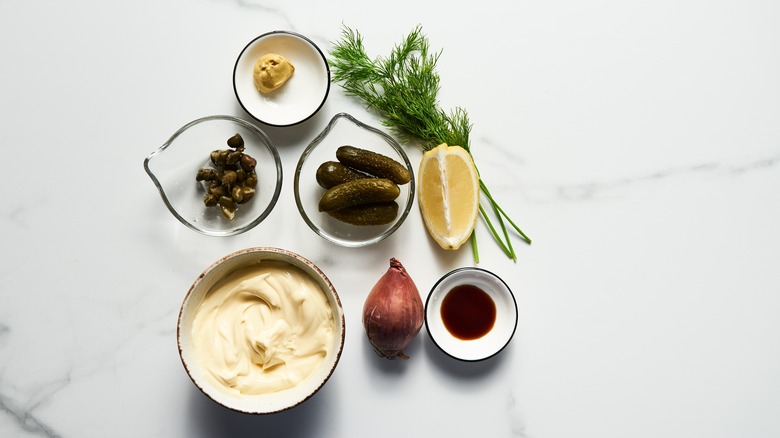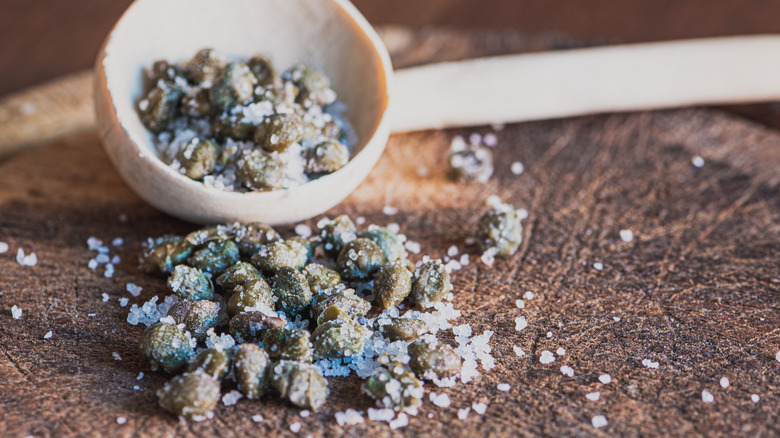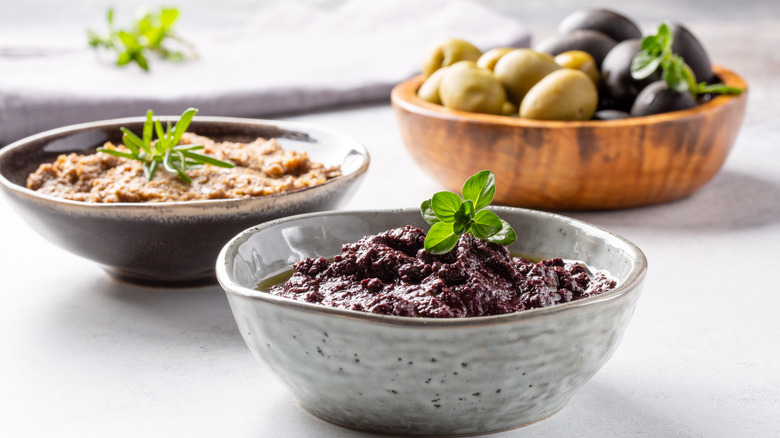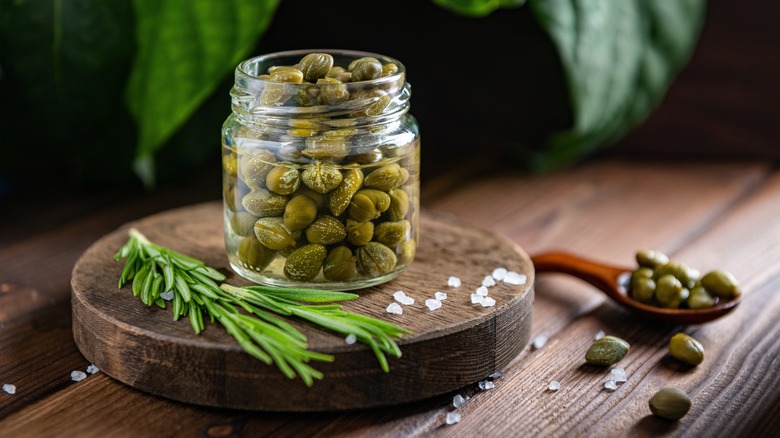12 Mistakes Everyone Makes With Capers
Capers can add a bright, acidic zinginess to dishes, but many people avoid these because they don't know how to use them. When it comes to capers there are a few obvious issues, such as using too many, that can put people off using them, but it goes way beyond overdoing it on these briny add-ins.
Read on, and you'll soon know more about the common varieties of capers, as well as the caperberry versus caper bud dilemma. Getting those two mixed up can throw your flavor game off balance. We'll also get started on the timing issue, as figuring out when to introduce capers into the culinary mix is its own challenge.
So, grab a seat as we take you on a journey through the common slip-ups folks make when it comes to briny, pungent capers. If you've ever felt like you just don't know what to do with capers or if you've made a mistake that's made you feel less than confident about using them ever again, then take heart, as you've come to the right place to find a solution. You'll soon be so confident with capers that you'll wonder why you were ever worried about them in the first place. Here are some of the most common caper-related missteps and how you can remedy them.
1. Not understanding the different varieties of capers
Capers come in quite a few different varieties, each with unique properties. So, understanding the differences amongst them can seriously elevate your culinary game. Often, people unwittingly fall into the trap of thinking all capers are created equal. However, the reality is that nuances exist that you will taste in a dish, and so a bit of caper knowledge can go a long way.
Caper size is often a good place to start. Smaller capers, such as the prized non-pareil variety, typically deliver a more delicate punch that is ideal for adding a finishing touch to salads or seafood dishes. Sufine capers are another small variety that's a good choice for finishing. On the other hand, larger capers, such as capotes, bring a more robust flavor that's perfect for heartier dishes like pasta or roasted meats. Mid-sized capers, like capucines, that are great all-rounders.
Recognizing their different flavor profiles ensures you select the right caper for the job. So, before you reach for that jar of capers, acquaint yourself with the diverse personalities within the caper family and unlock a world of culinary possibilities.
2. Not knowing the difference between capers and caperberries
In supermarket aisles, you might have seen both capers and caperberries for sale. But, while they may share some visual similarities, don't just assume that caperberries are simply oversized capers. Capers and caperberries are two decidedly different ingredients that you can't use interchangeably.
Smaller, pea-sized capers pack a robust, tangy punch. Think of them as flavor dynamos that bring a concentrated burst of acidity to elevate a range of dishes, from salads to pasta. But, what exactly are they? They're the unopened flower buds of the capparis shrub.
Now, shift your gaze to caperberries. These are larger than capers — typically, they resemble small grapes in size. You'd be forgiven for thinking they're just big capers, and they do indeed come from the same plant. However, these are the berries that develop after caper buds have bloomed. Their taste is more subtle than capers and is more akin to a pickled cucumber, offering a more subdued tang.
So, how do you decide which to use? If you desire a zesty, bold kick, capers should be your go-to. However, if you're envisioning a more delicate, nuanced symphony of flavors on your dish, then it's probably better to opt for caperberries. Understanding this difference will help to ensure that your culinary creations hit just the right note, harmonizing perfectly with the other elements on your plate.
3. Thinking there's no difference between brined, vinegared, and salt-packed capers
You might happily grab any jar of capers off the grocery shelf, thinking there are no differences between them. Not so fast. There are three different styles of capers you might find at the store — namely brined, vinegared, and salt-packed. Each offers a different experience. First, imagine a stroll through a coastal Mediterranean village, where the salty breeze mingles with the scent of blooming flowers. Brined capers encapsulate this essence. These little flavor bombs are preserved in a solution of water and salt, allowing them to retain their natural, robust tanginess. The process also imparts a briny depth, making these capers ideal for dishes that can handle their relatively intense flavor and put it in the spotlight.
Now enter vinegared capers. Immersed in a solution of vinegar, these add a brighter, more acidic note to meals. Use vinegared capers when you seek that extra zing in your salads, dressings, or sauces. However, it's worth noting that some people think the vinegar notes are often too strong, arguing that you mostly taste the vinegar instead of the more nuanced notes of the capers themselves.
Salt-packed capers are cured in layers of salt, a process that yields a mellower, more subdued flavor profile. You don't get the taste of the vinegar here, as it's never used, so the capers retain more of their natural taste. Because they're not soaked, these capers are also more firm and hold their shape better during cooking.
4. Not preparing them before use
If you've just been throwing capers into your dishes and wondering why the final flavors never seem quite right, then you may need to set aside a little extra time to prepare the additions. Before capers make their way into your meals, a few straightforward steps can ensure your capers are ready to contribute seamlessly to your culinary creations.
Salt-packed capers, as the name suggests, come packed in quite a lot of salt. If you don't rinse it off, your finished dish could easily become intensely salty. But just rinsing thecapers isn't necessarily enough to counter this effect in most cases. Instead, we recommend taking things a step further and soaking salt-packed capers in cold water for at least 15 minutes. Then rinse them and using as desired. This simple act greatly reduces the salinity and helps to unveil a more nuanced taste.
On the other side of the caper spectrum, brined and vinegared variants are quicker to prepare and use. While a brief rinse under cool water is still beneficial, especially if you want to temper the acidity, it isn't strictly necessary. These capers, having absorbed the essence of brine or vinegar, arrive with their flavors ready. A swift rinse merely reduces excess tanginess from vinegar or saltiness from brine. You can skip this step, especially if you're confident in tasting your dish as you go and adjusting other ingredients as necessary.
5. Adding them too early when you want a bright taste
Capers can impart a burst of brightness to your dishes. However, timing matters. When you add them to a recipe can make more of a difference than you might think. Revered for their bright floral notes with a briney complexity, capers can elevate a range of dishes. However, their distinct flavor can be dulled by the heat of cooking.
If you want to keep the taste of capers clear in your finished meal, add them close to the end of cooking. Similar to how you should handle many fresh herbs, capers only need a minute or two in the pan to let their flavor shine through. Any longer, and they will turn dull. Simply put, if you're looking for a fresh and zesty edge and you add capers early on in the cooking process, you won't get the results that you're looking for.
Whether you're concocting a vibrant pasta sauce, a refreshing salad, or a savory main course, adding capers toward the end ensures you'll get the most of those acidic notes. In fact, capers are ready to eat without cooking, so in some recipes, you might even sprinkle them top or stir them through after you've taken the dish off the heat to retain the fullest flavor.
6. Adding them too late when you want flavors to meld
While capers are often celebrated for their vibrant notes when they are added towards the end of cooking, there are also meals where you may want a more pared-back flavor. In dishes where you want greater subtlety and a more thorough melding of flavors, you should add capers earlier in the process. The prolonged exposure to heat allows capers to infuse their essence more deeply into the dish than they would have one otherwise, becoming an integral part of the flavor foundation. As they simmer alongside other ingredients, capers contribute to a cohesive blend of flavors rather than asserting their individual brilliance.
Consider a slow-cooked stew, where capers, at least when they have been added in the initial stages of cooking, lend a subtle tanginess to the broth, thus weaving themselves into the very fabric of the dish. While the conventional wisdom may advocate for the late entrance of capers to preserve their characteristic acidity, the truth is that the world of cooking embraces flexibility.
In recipes where the goal is to create a dish where the whole is greater than the sum of its parts, you'll want capers to play more of a supporting role. Rather than being the bright, punchy star of the show, capers that have been given a longer cooking time will impart more nuanced notes into a dish without being an obvious addition.
7. Not balancing them with another acidic ingredient
It's clear that achieving the perfect balance of flavors in a dish is an art form. One secret to unlocking the full potential of capers lies in balancing them with acidic ingredients. The companion of choice? Lemon juice. Going without this burst of acidity is a mistake that can leave your meal flat and uninspiring.
Capers can add depth to a dish. However, to truly make their flavors sing, a counterpoint is needed, which is precisely where lemon juice steps onto center stage. The bright and citrusy essence of lemons complements briny flavor notes of the capers, accentuating the taste of the capers without utterly overpowering them. This simple addition acts as a culinary spotlight, ensuring that each ingredient plays its part without stealing the show. Picture a forkful of caper-studded pasta, where the subtle tang of lemon juice cuts through the richness, leaving you with a symphony of flavors that lingers on the palate.
Whatever you're whipping up in the kitchen, the judicious use of lemon juice can be your culinary secret weapon. And, once you learn to balance flavors in this way, it opens up the door for more experimentation and even tastier dishes. Other acids, such as a high-quailty vinegar, may work well here, too.
8. Not using capers in dressings
If you aren't using capers in dressings, you need to remedy that, and fast. These additions add a delightful hit of briny sophistication to your dressings, allowing you to easily elevate even the simplest salads to gourmet heights. To harness the full essence of capers in dressings, it's key to start with a solid foundation, such as a vinaigrette made with high-quality olive oil and vinegar. Be sure to finely chop the capers in order to most fully release their concentrated flavor into the mix. Don't shy away from including a spoonful of caper brine, either, which can both amp up the flavor and loosen an overly thick dressing.
The addition of capers brings a nuanced complexity that introduces a layer of umami flavor to better complement the acidity of vinegar or lemon juice. This interplay of flavors can really elevate a mundane dressing. Make a caper-infused dressing to drizzle over a crisp green salad, but don't stop there. Toss it with pasta or use it as a marinade for freshly grilled vegetables.
Don't be afraid to get creative, either, as you can easily tailor the other ingredients in the dressing to fit what you're making. For instance, you might add fresh basil to a dressing for pasta salad or garlic and ginger to one intended for a rice noodle salad. In either case, capers bring a lot to both parties.
9. Always using them whole
Think you always have to use capers whole? Then you're missing out on some serious culinary opportunities. While whole capers contribute a burst of briny intensity and also look good, only ever using them whole is like only cooking whole carrots or never chopping olives.
Chopping capers allows for a more even distribution of their distinctive flavor, helping to avoid the risk of encountering pockets of overpowering flavor that whole capers sometimes impart. This smoother integration can seamlessly weave caper essence into the fabric of your dush and ensure that each bite is balanced.
This culinary finesse is particularly good in dishes where you want a more nuanced caper presence, as in pasta puttanesca, where a subtle brininess can enhance the overall flavor profile. The versatility of chopped capers extends beyond their conventional use, too, so you think about using them in dishes where they might not usually belong. Sure, whole capers are great, but if you only ever use them whole, it's time that you get out the knife, get to chopping, and expand your culinary horizons.
10. Not using them as a substitute for anchovies
If you've never thought about using capers as a stand-in for anchovies, you're just about to unlock a whole avenue of new possibilities. This revelation is not only useful when you don't have anchovies on hand in the panty, but it's a delightful choice for vegetarians and vegans who are seeking plant-based alternatives, not to mention people who simply don't like seafood. Anchovies can be divisive, after all, so it's good to have an easy alternative.
The umami-rich essence of anchovies is a coveted element in many classic recipes, whether they're at the center of the action or contributing to a rich, savory base. For anchovy haters or those who adhere to vegetarian or vegan diets, however, the quest for an equally satisfying flavor profile can be challenging. Capers can impart a similar depth of flavor, but without the fishy taste that some find offputting.
Capers have a distinctive brininess and piquant notes that work well in dishes that traditionally rely on anchovies for flavor, including some pasta sauces, salad dressings, and tapenades. Capers provide a strategic solution, infusing these dishes with robust, savory notes akin to the anchovy experience. They might be small, but they can pack a punch.
11. Throwing out leftover capers too soon
It's rare that you'll use a whole jar of capers in one recipe, meaning you're often left with some lingering in your fridge. If you're an occasional caper user, this might mean your capers end up languishing for months. More often than not, people throw them away after a few weeks or months, thinking that they're surely no longer safe to eat. However, this is often a mistake.
Stored properly in the refrigerator, capers boast an impressive shelf life, whether they've been brined, vinegared, or salt-packed. It's common for capers to last for a year or more in the fridge, even once opened, thanks to the bacteria-fighting qualities of salt and acid. Rather than pay too much attention to best-before dates, instead look for signs that the capers have spoiled. These include any black or brown capers in the jar, spots of mold, or a pungent smell that wafts up when you open the jar. Unlike use by dates, best before dates are more of a guideline than a directive. If your capers look and smell fine outside of the best-before date, they'll likely still be okay to eat.
So, the next time you contemplate parting ways with that jar of capers tucked away in the fridge, think twice. They can last through a few seasons and changing culinary trends, so even if you aren't using them much right now, they could still be ready to use by next time you enter a caper era.
12. Getting rid of caper brine
When you're done with a jar of brined capers, it seems logical to throw the liquid down the sink and recycle the jar. Don't be too hasty, as caper brine can enhance a wide range of dishes. One option is to transform it into a vinaigrette. Simply combine caper brine with olive oil, Dijon mustard, and a touch of honey for a dressing that adds complexity to salads, roasted vegetables, or any number of grilled proteins. The brine's acidity will work to balance out the richness of the olive oil and sweetness from honey.
You can also infuse meats, tofu, or vegetables with the essence of capers by incorporating the brine into marinades, especially when it's blended with ingredients like garlic, herbs, and citrus. If you're making a creamier mayo-based dressing, the acid in caper brine can cut through the richness and add a new dimension that's a step above standard lemon juice. You can also use it in basically any savory dish that calls for some form of vinegar or lemon juice
Go even further and embrace the unexpected by introducing caper brine into your cocktail repertoire. A splash of caper brine can lend a bracing acidity to savory cocktails like a Bloody Mary or bring new life to a dirty martini in place of the more traditional olive brine.
